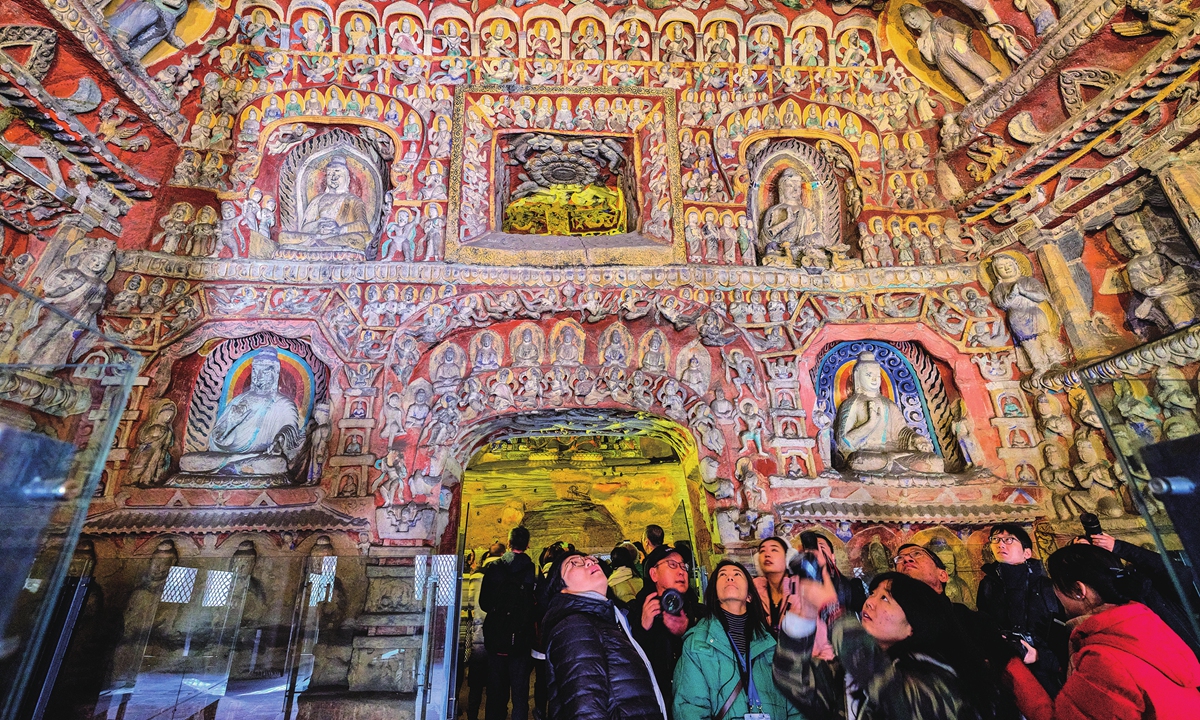Yungang Grottoes: Discovering the cultural significance of a nation’s strength
Historical wonder

Visitors in a cave of the Yungang Grottoes Photo:VCG
When I traveled to the Yungang Grottoes in Datong last weekend, I was amazed by the exquisite Buddhist cave art left by ancient craftsmen. As I was admiring the general splendor however, I suddenly noticed something unusual.
Returning treasures
"Where is the head of this Buddha?" I asked our tour guide, pointing to a statue on the wall.
"It was stolen by a curio dealer before the founding of the People's Republic of China in 1949. After several rounds of sales, it is believed that the head is now part of a French lamp," the guide continued.
Upon hearing the guide's explanation, bystanders let out disapproving whispers, yet undeterred, the guide seamlessly turned to another captivating story.
The year before, he said, he had welcomed a visitor from New York to the Yungang Grottoes. The visitor noticed at the time that two Buddha statues were absent from one cave. Our guide told him that the two art pieces are now on display at the Metropolitan Museum of Art in New York.
The man was taken aback and, after he returned to New York, he went to the Metropolitan Museum of Art, took a picture of himself with the two statues and sent it back to the guide. As the guide was proudly showing us the picture however, I heard someone in the crowd mutter: "What a pity. Such things would never happen nowadays."
Our guide said that roughly 1,000 pieces of Buddha statues have been stolen from the Yungang Grottoes, which happened back in a time when people were poor and ill-educated.
The Yungang Grottoes, located in Datong, North China's Shanxi Province, are one of the three most famous grottoes in China. With a history of 1,500 years, they are known for their imposing statues, the number of relics and fine carvings. As the largest and the only imperial grottoes in China, the Yungang Grottoes boast 254 caves that host more than 59,000 statues. The grottoes, which feature 45 major caves, were inscribed on the UNESCO World Cultural Heritage list in 2001.
As a Chinese citizen, the realization that our cherished ancient relics have suffered damage or theft is truly disheartening. However, this unfortunate reality made us acknowledge and appreciate the tremendous efforts undertaken to safeguard these invaluable cultural treasures.
China has intensified efforts to track down missing cultural relics from abroad in recent years.
In 2018, a 1,500-year-old head of the statue that was stolen from the Yungang Grottoes was successfully returned to China. The 26.5-centimer-tall, 12-centimer-wide statue head was donated to the Shanxi Museum by John S. C. Wang and his wife.
Protection
In 2020, 68 cultural relics were returned to China from the UK. These artifacts, which had been smuggled overseas, were retrieved following joint efforts from the administration and the China's foreign affairs and customs authorities.
Similarly, in 2019, the US also returned 361 Chinese relics and artifacts to China.
While being proud of its increasing recognition in global academic circles, the local authorities and researchers understand that protecting the Yungang Grottoes, exposed to wind, rain and snow for over 1,500 years, has become a pressing challenge.
Efforts in protection have been enhanced since the establishment of Yungang Grottoes Academy in February 2021. The "Yungang Grottoes Academy was launched to replace the former Datong Institution for the Preservation of Yungang Grottoes," Zhang Zhuo, head of the academy told the media. "Cultural heritage protection is a major task for the Yungang Grottoes Academy."
Main protection operations have been ongoing over the past decades, starting from the founding of the People's Republic of China.
In 1961, the Yungang Grottoes were listed as cultural heritage under state protection.
In the 1970s, a massive three-year national project for the Yungang Grottoes was initiated for the first time. The project included building protective walls, consolidating some grottoes as well as paving the caves with cloth to prevent water seepage from the ceilings.
Yan Hongbin, head of the Yungang Grottoes Academy studio for relics preservation and repair, is one of the researchers working on cultural heritage protection.
He and his team have proposed a number of solutions for preservation with the use of new technologies.
Media reported that recently cutting-edge technologies have been employed. For example, researchers are using ultrasound testing devices that are customized for grotto statues. This technology provides clear and distinguishable images that are not easily observed by the naked eye.
Zhang Shaoyou, a staff member of the Cultural Heritage Protection and Monitoring Center of the Yungang Research Institute explained:
"We may not see much damage on the surface, but through this device, we can see that it is more weathered than it looks, especially when it comes to hollowing."
"People feel a deep sense of sorrow when they see cultural relics deteriorate, because these works of ancient art are irreplaceable. Therefore, researchers are exerting their utmost effort to restore them to their former glory," concluded our guide.

